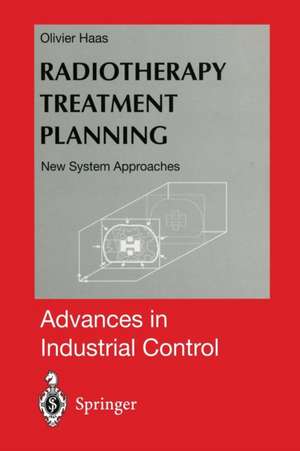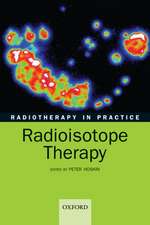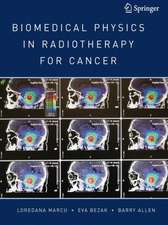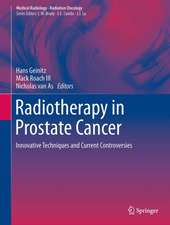Radiotherapy Treatment Planning: New System Approaches: Advances in Industrial Control
Autor Olivier C. Haasen Limba Engleză Paperback – 25 iul 2012
Din seria Advances in Industrial Control
- 15%
 Preț: 643.34 lei
Preț: 643.34 lei - 23%
 Preț: 582.63 lei
Preț: 582.63 lei - 18%
 Preț: 783.98 lei
Preț: 783.98 lei - 18%
 Preț: 947.35 lei
Preț: 947.35 lei - 20%
 Preț: 568.24 lei
Preț: 568.24 lei - 15%
 Preț: 643.16 lei
Preț: 643.16 lei - 18%
 Preț: 899.21 lei
Preț: 899.21 lei - 18%
 Preț: 891.33 lei
Preț: 891.33 lei - 18%
 Preț: 740.57 lei
Preț: 740.57 lei - 18%
 Preț: 961.23 lei
Preț: 961.23 lei - 18%
 Preț: 955.08 lei
Preț: 955.08 lei - 15%
 Preț: 645.28 lei
Preț: 645.28 lei - 15%
 Preț: 638.43 lei
Preț: 638.43 lei - 18%
 Preț: 901.11 lei
Preț: 901.11 lei - 18%
 Preț: 1410.94 lei
Preț: 1410.94 lei - 18%
 Preț: 728.91 lei
Preț: 728.91 lei - 20%
 Preț: 1003.77 lei
Preț: 1003.77 lei - 18%
 Preț: 947.35 lei
Preț: 947.35 lei - 15%
 Preț: 643.34 lei
Preț: 643.34 lei - 15%
 Preț: 654.30 lei
Preț: 654.30 lei - 18%
 Preț: 950.52 lei
Preț: 950.52 lei - 15%
 Preț: 644.30 lei
Preț: 644.30 lei - 18%
 Preț: 1393.09 lei
Preț: 1393.09 lei - 18%
 Preț: 950.21 lei
Preț: 950.21 lei - 18%
 Preț: 949.90 lei
Preț: 949.90 lei - 18%
 Preț: 949.42 lei
Preț: 949.42 lei - 18%
 Preț: 950.52 lei
Preț: 950.52 lei - 18%
 Preț: 1113.71 lei
Preț: 1113.71 lei - 15%
 Preț: 650.04 lei
Preț: 650.04 lei - 15%
 Preț: 644.95 lei
Preț: 644.95 lei - 18%
 Preț: 950.33 lei
Preț: 950.33 lei - 18%
 Preț: 948.61 lei
Preț: 948.61 lei - 18%
 Preț: 1112.60 lei
Preț: 1112.60 lei - 15%
 Preț: 644.63 lei
Preț: 644.63 lei - 18%
 Preț: 953.20 lei
Preț: 953.20 lei - 18%
 Preț: 945.62 lei
Preț: 945.62 lei - 15%
 Preț: 640.88 lei
Preț: 640.88 lei - 15%
 Preț: 640.88 lei
Preț: 640.88 lei - 20%
 Preț: 650.92 lei
Preț: 650.92 lei - 18%
 Preț: 1112.60 lei
Preț: 1112.60 lei - 20%
 Preț: 998.36 lei
Preț: 998.36 lei - 15%
 Preț: 643.34 lei
Preț: 643.34 lei - 18%
 Preț: 948.92 lei
Preț: 948.92 lei - 18%
 Preț: 1381.43 lei
Preț: 1381.43 lei - 15%
 Preț: 651.51 lei
Preț: 651.51 lei - 15%
 Preț: 647.08 lei
Preț: 647.08 lei - 20%
 Preț: 563.66 lei
Preț: 563.66 lei - 18%
 Preț: 992.64 lei
Preț: 992.64 lei - 18%
 Preț: 1225.79 lei
Preț: 1225.79 lei
Preț: 712.81 lei
Preț vechi: 750.33 lei
-5% Nou
Puncte Express: 1069
Preț estimativ în valută:
136.40€ • 142.70$ • 113.30£
136.40€ • 142.70$ • 113.30£
Carte tipărită la comandă
Livrare economică 02-16 aprilie
Preluare comenzi: 021 569.72.76
Specificații
ISBN-13: 9781447112105
ISBN-10: 1447112105
Pagini: 244
Ilustrații: XX, 220 p. 84 illus.
Dimensiuni: 155 x 235 x 13 mm
Greutate: 0.35 kg
Ediția:Softcover reprint of the original 1st ed. 1999
Editura: SPRINGER LONDON
Colecția Springer
Seria Advances in Industrial Control
Locul publicării:London, United Kingdom
ISBN-10: 1447112105
Pagini: 244
Ilustrații: XX, 220 p. 84 illus.
Dimensiuni: 155 x 235 x 13 mm
Greutate: 0.35 kg
Ediția:Softcover reprint of the original 1st ed. 1999
Editura: SPRINGER LONDON
Colecția Springer
Seria Advances in Industrial Control
Locul publicării:London, United Kingdom
Public țintă
Professional/practitionerCuprins
1. Introduction and Brief Review of Developments in Radiotherapy.- 1.1 Introduction.- 1.2 Historical Review of Developments in Radiotherapy.- 1.3 Radiotherapy Treatment Planning Procedures.- 1.4 Background to the Optimisation of Radiotherapy Treatment Plans.- 1.5 Optimisation in Radiotherapy: A Brief Review.- 1.6 Concluding remarks.- 2. Beam Characteristics and Preliminary Modelling Considerations.- 2.1 Introduction.- 2.2 Need for an Appropriate Model Structure.- 2.3 Preliminary Physical Consideration.- 2.4 Typical Beam Characteristics.- 2.5 Concept of Primary Modelling and Scatter Phenomenon.- 2.6 Concluding Remarks.- 3. Formulation of Matrix Based Beam Model.- 3.1 Introduction.- 3.2 Parallel Pencil Beam Model Formulation.- 3.3 Divergent Pencil Beam Matrix Formulation.- 3.4 Inclusion of In-Air-Profile, Penumbra and Patient Contour Correction.- 3.5 Verification and Tuning of Developed Beam Model.- 3.6 Concluding Remarks.- 4. Solving the Inverse Problem in Radiotherapy Treatment Planning.- 4.1 Introduction.- 4.2 Definition of the Inverse Problem.- 4.3 Formulating the Inverse Problem for Matrix Based Beam Model.- 4.4 Articulation of the Objectives.- 4.5 Improving the Rate of Convergence of the Algorithm.- 4.6 Simulation Studies.- 4.7 Concluding remarks.- 5. Hybrid Genetic Algorithms Applied to Radiotherapy Treatment Planning.- 5.1 Introduction.- 5.2 Genetic Algorithms.- 5.3 Multi-Objective Genetic Algorithms.- 5.4 Optimisation of Coplanar Beam Orientation in Radiotherapy.- 5.5 Optimisation of Beam Weights and Wedge Angles.- 5.6 Concluding Remarks.- 6. Experimental Verification of Overall Approach.- 6.1 Introduction.- 6.2 Optimisation of Conformal Radiotherapy Treatment.- 6.3 Modulating Beam Intensity with Compensators.- 6.4 Experimental Verification of Intensity ModulatedRadiation Therapy.- 6.5 Concluding remarks.- 7. Conclusions.- References.
Textul de pe ultima copertă
This volume contains an in depth examination of many of the complex issues associated with planning and optimisation of intensity modulated radiotherapy treatment.
The book is divided into five parts: a presentation of current practice, techniques and equipment used by medical physicists and others to deliver radiotherapy treatment; a systems modelling approach is used in the formulation of a beam model for the purpose of optimisation, describing the effect of X-rays on human body tissues whilst taking all the relevant factors into account; a deterministic approach to the inverse problem in radiotherapy, based on weighted iterative least squares is modified to allow an adaptive scaling of the error to improve the performance of a general least squares algorithm; a guided random search methodology, based on genetic algorithms which is specifically aimed at solving multi-objective optimisation problems is developed to optimise beam weight/wedge angle as well as coplanar beam orientation; the overall approach developed is demonstrated practically using both traditional and modern measurement techniques such as film and more modern techniques such as gel dosimeter.
The work is essential for all those involved in the broad area of medical engineering, and will be an invaluable addition to libraries, institutions and for students of the subject at all levels.
Advances in Industrial Control aims to report and encourage the transfer of technology in control engineering. The rapid development of control technology has an impact on all areas of the control discipline. The series offers an opportunity for researchers to present an extended exposition of new work in all aspects of industrial control.
The book is divided into five parts: a presentation of current practice, techniques and equipment used by medical physicists and others to deliver radiotherapy treatment; a systems modelling approach is used in the formulation of a beam model for the purpose of optimisation, describing the effect of X-rays on human body tissues whilst taking all the relevant factors into account; a deterministic approach to the inverse problem in radiotherapy, based on weighted iterative least squares is modified to allow an adaptive scaling of the error to improve the performance of a general least squares algorithm; a guided random search methodology, based on genetic algorithms which is specifically aimed at solving multi-objective optimisation problems is developed to optimise beam weight/wedge angle as well as coplanar beam orientation; the overall approach developed is demonstrated practically using both traditional and modern measurement techniques such as film and more modern techniques such as gel dosimeter.
The work is essential for all those involved in the broad area of medical engineering, and will be an invaluable addition to libraries, institutions and for students of the subject at all levels.
Advances in Industrial Control aims to report and encourage the transfer of technology in control engineering. The rapid development of control technology has an impact on all areas of the control discipline. The series offers an opportunity for researchers to present an extended exposition of new work in all aspects of industrial control.
Caracteristici
Covers all the new system approaches and complex issues surrounding the subject Has a wide appeal, and will be relevant for all those involved in the industry Has many ideas for further research and development on the topic



















